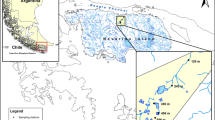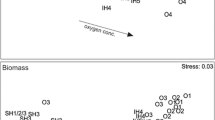Abstract
The objective of this study was to explore the altitudinal decrease in local richness of stream macroinvertebrates. I compared the explicatory power of a mid-domain effect (MDE) null model and a number of selected contemporary ecological variables, with a special emphasis on the altitude-mediated decrease in temperature and oxygen availability as possible driving factors for the observed pattern. Benthic macroinvertebrates were sampled at 30 stream sites between 2,600 and 4,000 m a.s.l. in northern Ecuador. All four measures of local richness (total number of taxa, taxa in Surber samples, Fisher’s α index and rarefied richness) decreased with increasing altitude. The MDE null model, water temperature and dissolved oxygen also decreased with altitude, while other measured variables were uncorrelated with altitude. Minimum oxygen saturation had the highest explanatory power of the density-corrected Fisher’s α and rarefied richness (R = 0.48 and 0.52, respectively), but also minimum temperature (R = 0.48 and 0.41) and the MDE null model (R = 0.48 and 0.46) correlated significantly. Multiple regression analyses using several predictive variables showed that oxygen saturation had the greatest and only significant effect on density-corrected richness. The relationship between richness and oxygen corrected for the effect of altitude (using analyses of double residuals) was significant, whereas that of richness versus temperature was not. The results indicate that the decrease in richness with increasing altitude is mainly caused by a decrease in oxygen saturation rather than by a decrease in temperature. Levels of oxygen saturation such as those found at high altitudes do not appear to be lethal to any species, but could affect macroinvertebrates through long-term, sub-lethal effects. I suggest that low oxygen availability may limit biodiversity at high altitudes not only in the aquatic, but also in the terrestrial environment.



Similar content being viewed by others
References
Allan JD (1995) Stream ecology, structure and function in running waters. Chapman & Hall, London
Bailey RC, Norris RH, Reynoldson TB (2001) Taxonomic resolution of benthic macroinvertebrate communities in bioassessments. J N Am Benthol Soc 20:280–286
Baltagi BH (1999) Econometrics. Springer, Berlin
Benedetto L (1970) Observations on the oxygen needs of some species of European Plecoptera. Intern Rev Ges Hydrobiol 55:505–510
Bournaud M, Cellot B, Richoux P, Berrahou A (1996) Macroinvertebrate community structure and environmental characteristics along a large river: congruity of patterns for identification to species or family. J N Am Benthol Soc 15:232–253
Bowman MF, Bailey RC (1997) Does taxonomic resolution affect the multivariate description of the structure of freshwater benthic macroinvertebrate communities? Can J Fish Aqua Sci 54:1802–1808
Brehm G, Colwell RK, Kluge J (2007) The role of environmental and mid-domain effect on moth species richness along a tropical elevational gradient. Global Ecol Biogeogr 16:205–219
Brown JH, Lomolino MJ (1998) Biogeography, 2nd edn. Sinauer, Sunderland, Mass.
Colwell RK, Hurtt GC (1994) Nonbiological gradients in species richness and a spurious Rapoport effect. Am Nat 144:570–595
Colwell RK, Lees DC (2000) The mid-domain effect: geometric constrains on the geography of species richness. Trends Ecol Evol 15:70–76
Colwell RK, Rahbek C, Gotelli NJ (2004) The mid-domain effect and species richness patterns: what have we learned so far? Am Nat 163:E1–E23
Connolly NM, Crossland MR, Pearson RG (2004) Effect of low oxygen on survival, emergence and drift of tropical stream macroinvertebrates. J N Am Benthol Soc 23:251–270
Currie DJ (1991) Energy and large-scale patterns of animal- and plant-species richness. Am Nat 137:27–49
Dolédec S, Olivier JM, Statzner B (2000) Accurate description of the abundance of taxa and their biological traits in stream invertebrate communities: effects of taxonomic and spatial resolution. Arch Hydrobiol 148:25–43
Dunn RR, Colwell RK, Nilsson C (2006) The river domain: why are there more species halfway up the river? Ecography 29:251–259
Eriksen CH, Lamberti GA, Resh VH (1996) Aquatic insect respiration. In: Merritt RW, Cummins KW (eds) An introduction to the aquatic insects of North America, 3rd edn. Kendall/Hunt, Dubuque, pp 29–40
Freckleton RP (2002) On the misuse of residuals in ecology: regression of residuals vs. multiple regression. J Anim Ecol 71:542–545
Giller PS, Malmqvist B (1998) The biology of streams and rivers. Oxford University Press, Oxford
Golubkov SM, Tiunova TM (1989) Dependence of the respiration rate upon oxygen concentration in water for some rheophilous mayfly larvae (Ephemeroptera). Aquat Insects 11:147–151
Golubkov SM, Tiunova TM, Kocharina SL (1992) Dependence of the respiration rate of aquatic insects upon the oxygen concentration in running and in still water. Aquat Insects 14:137–144
Gotelli NJ, Colwell RK (2001) Quantifying biodiversity: procedures and pitfalls in the measurement and comparison of species richness. Ecol Lett 4:379–391
Grytnes JA, Vetaas OR (2002) Species richness and altitude: a comparison between null models and interpolated plant species richness along the Himalayan altitude gradient, Nepal. Am Nat 159:294–304
Halloy S (1989) Altitudinal limits of life in subtropical mountains: what do we know? Pac Sci 43:170–184
Hawkins BA, Diniz-Filho JAF (2002) The mid-domain effect does not explain the diversity gradient of Nearctic birds. Global Ecol Biogeogr 11:419–426
Hawkins BA, Diniz-Filho JAF, Weis AE (2005) The mid-domain effect and diversity gradients: is there anything to learn? Am Nat 166:E140–E143
Hayashi F (1989) Respiratory responses of aquatic insects to low oxygen concentration. Jpn J Limnol 50:255–268
Herzog SK, Kessler M, Bach K (2005) The elevational gradient in Andean bird species richness at the local scale: a foothill peak and a high-elevation plateau. Ecography 28:209–222
Hynes HBN (1970) The ecology of running waters. Liverpool Press, Liverpool
Illies J (1964) The invertebrate fauna of the Huallaga, a Peruvian tributary of the Amazon river, from the sources down to Tingo Maria. Verh Int Ver Limnol 15:1077–1083
Jacob U, Walther H (1981) Aquatic insect larvae as indicators of limiting minimal contents of dissolved oxygen. Aquat Insects 3:219–224
Jacobsen D (2003) Altitudinal changes in diversity of macroinvertebrates from small streams in the Ecuadorian Andes. Arch Hydrobiol 158:145–167
Jacobsen D (2004) Contrasting patterns in local and zonal family richness of stream invertebrates along an Andean altitudinal gradient. Freshwater Biol 49:1293–1305
Jacobsen D (2008) Tropical high-altitude streams. In: Dudgeon D (ed) Aquatic ecosystems: tropical stream ecology. Elsevier, Amsterdam, pp 219–256
Jacobsen D, Friberg N (1997) Macroinvertebrate communities in Danish streams: the effect of riparian forest cover. In: Sand-Jensen K, Pedersen O (eds) Freshwater biology in Denmark—priorities and development in Danish research. GAD, Copenhagen, pp 208–222
Jacobsen D, Schultz R, Encalada A (1997) Structure and diversity of stream macroinvertebrate assemblages: the effect of temperature with altitude and latitude. Freshwater Biol 38:247–261
Jacobsen D, Rostgaard S, Vásconez JJ (2003) Are macroinvertebrates in high altitude streams affected by oxygen deficiency? Freshwater Biol 48:2025–2032
Janzen DH, Ataroff M, Fariñas M, Ricon RN, Soler A, Soriano P, Vera M (1976) Changes in the arthropod community along an elevational transect in the Venezuelan Andes. Biotropica 8:193–203
Kalff J (2002) Limnology. Prentice Hall, Englewood Cliffs, N.J.
Lawton J (1996) Patterns in ecology. Oikos 75:145–147
Lenat DR, Resh VH (2001) Taxonomy and stream ecology—the benefits of genus and species level identification. J N Am Benthol Soc 20:287–298
Lomolino MV (2001) Elevation gradients of species-density: history and prospective views. Global Ecol Biogeogr 10:3–13
Mani MS (1968) Ecology and biogeography of high altitude insects. Junk, The Hague
McCain CM (2007) Could temperature and water availability drive elevational species richness patterns? A global case study for bats. Global Ecol Biogeogr 16:1–13
McCoy EA (1990) The distribution of insects along elevational gradients. Oikos 58:313–322
Merritt RW, Cummins KW (eds) (1996) An introduction to the aquatic insects of North America, 3rd edn. Kendall/Hunt, Dubuque
Monaghan KA, Peck MR, Brewin PA, Masiero M, Zarate E, Turcotte P, Ormerod SJ (2000) Macroinvertebrate distribution in Ecuadorian hill streams: the effect of altitude and land use. Arch Hydrobiol 149:421–440
Nagell B, Larshammer P (1981) Critical oxygen demand in Plecoptera and Ephemeroptera nymphs as determined by two methods. Oikos 36:75–82
Navas CA (2003) Herpetological diversity along Andean elevational gradients: links with physiological ecology and evolutionary physiology. Comp Biochem Physiol A 133:469–485
Nebeker AV (1972) Effect of low oxygen concentration on survival and emergence of aquatic insects. Trans Am Fish Soc 4:675–679
Nor SM (2001) Elevational diversity patterns of small mammals on Mount Kinabalu, Sabah, Malaysia. Global Ecol Biogeogr 10:41–62
Rahbek C (1995) The elevational gradient of species richness: a uniform pattern? Ecography 18:200–205
Rahbek C (1997) The relationship among area, elevation, and regional species richness in neotropical birds. Am Nat 149:875–902
Rahbek C (2005) The role of spatial scale and the perception of large-scale species-richness patterns. Ecol Lett 8:224–239
Rangel TFLVB, Diniz-Filho JAF, Bini LM (2006) Towards an integrated computational tool for spatial analysis in macroecology and biogeography. Global Ecol Biogeogr 15:321–327
Rohde K (1992) Latitudinal gradients in species diversity: the search for the primary cause. Oikos 65:514–527
Rohde K (1999) Latitudinal gradients in species diversity and Rapoport’s rule revisited: a review of recent work and what can parasites teach us about the causes of the gradients? Ecography 22:593–613
Roldán G (1992) Guía para el Estudio de los Macroinvertebrados Acuáticos del Departamento de Antioquia. Fondo Fen Colombia. Universidad de Antioquia, Colombia
Rosenzweig ML, Abramsky Z (1993) How are diversity and productivity related? In: Richlefs RE, Schlutter D (eds) Species diversity in ecological communities. The University of Chicago Press, Chicago, Ill., pp 52–65
Rostgaard S, Jacobsen D (2005) Respiration rate of stream insects measured in situ along a large altitude range. Hydrobiol 549:79–98
Sanders NJ (2002) Elevational gradients in ant species richness: area, geometry, and Rapoport’s rule. Ecography 25:25–32
Suren AM (1994) Macroinvertebrate communities of streams in western Nepal: effects of altitude and land use. Freshwater Biol 32:323–336
Tate CM, Heiny JS (1995) The ordination of benthic invertebrate communities in the South Platte River basin in relation to environmental factors. Freshwater Biol 33:439–454
Thorp JH, Covich AP (eds) (1991) Ecology and classification of North American freshwater invertebrates. Academic Press, San Diego, Calif.
Veech JA (2000) A null model for detecting non-random patterns of species richness along spatial gradients. Ecology 81:1143–1149
Ward JV (1986) Altitudinal zonation in a Rocky mountain stream. Arch Hydrobiol Suppl 74:133–199
Wetzel RG (2001) Limnology: lake and river ecosystems. Academic Press, New York
Williams PH, Gaston KJ (1994) Measuring more of biodiversity: can higher-taxon richness predict wholescale species richness? Biol Conserv 67:211–217
Williams DD, Tavares AF, Bryant E (1987) Respiratory device or camouflage? A case for the caddisfly. Oikos 50:42–52
Winter A, Ciborowski JJH, Reynoldson TB (1996) Effects of chronic hypoxia and reduced temperature on survival and growth of burrowing mayflies, Hexagenia limbata (Ephemeroptera: Ephemeridae). Can J Fish Aquat Sci 53:1565–1571
Wright JF, Moss D, Furse MT (1998) Macroinvertebrate richness at running-water sites in Great Britain: a comparison of species and family richness. Ver Int Verein Limnol 26:1174–1178
Zapata FA, Gaston KJ, Chown SL (2003) Mid-domain models of species richness gradients: assumptions, methods and evidence. J Anim Ecol 72:677–690
Zapata FA, Gaston KJ, Chown SL (2005) The mid-domain effect revisited. Am Nat 166:E144–E148
Acknowledgements
I am grateful to Lissette Carvajal for field assistance and to Renata Breitenfeldt for sorting of samples in the laboratory. I thank Kaj Sand-Jensen and anonymous reviewers for valuable comments on the paper. The Escuela de Ciencias Biológicas at the Universidad Católica del Ecuador in Quito provided facilities and the Freshwater Biological Laboratory at the University of Copenhagen tolerated my long absences. The funding from the Danish Natural Science Foundation (SNF) through grant 21-03-0318 is highly appreciated.
Author information
Authors and Affiliations
Corresponding author
Additional information
Communicated by Roland Brandl.
Electronic supplementary material
Below is the link to the Electronic supplementary material.
442_2007_877_MOESM1_ESM.xls
Appendix 1. Environmental characteristics of 30 stream sites in the Ecuadorian Andes. Values of width, depth, current, Froude number, specific discharge, pH and conductivity represent near base-flow conditions. (XLS 33 kb)
Rights and permissions
About this article
Cite this article
Jacobsen, D. Low oxygen pressure as a driving factor for the altitudinal decline in taxon richness of stream macroinvertebrates. Oecologia 154, 795–807 (2008). https://doi.org/10.1007/s00442-007-0877-x
Received:
Accepted:
Published:
Issue Date:
DOI: https://doi.org/10.1007/s00442-007-0877-x




